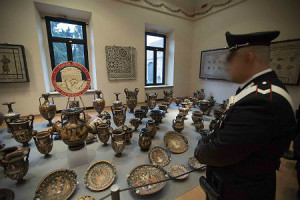 The start of 2015 has been triumphant for the Italian Carabinieri’s Tutela Patrimonio Culturale (http://www.carabinieri.it/cittadino/tutela/patrimonio-culturale/introduzione), the organization’s cultural heritage task force, known as its “Art Squad.” In January, it was announced that a cache of antiquities, valued at $58 million were recovered in Switzerland. (http://nypost.com/2015/01/21/italy-unveils-record-58m-haul-of-antiquities-from-swiss-raids/) The looted works had been smuggled from Italy across the border over the past decade. The Carabinieri, Italy’s military police, recovered rare antiquities seized during raids by Swiss police in Basel at the warehouses of a well-known Sicilian art dealer, Gianfranco Becchina. Becchina is infamous in the cultural heritage realm for his role in the black market antiquities trade, and was profiled in the book “The Medici Conspiracy.” According to a Carabinieri official, Mariano Mossa, “This is by a long shot the biggest recovery in history in terms of the quantity and quality of the archaeological treasures.” The recovery was celebrated internationally with the release of photos of a large storeroom of recovered treasures.
The start of 2015 has been triumphant for the Italian Carabinieri’s Tutela Patrimonio Culturale (http://www.carabinieri.it/cittadino/tutela/patrimonio-culturale/introduzione), the organization’s cultural heritage task force, known as its “Art Squad.” In January, it was announced that a cache of antiquities, valued at $58 million were recovered in Switzerland. (http://nypost.com/2015/01/21/italy-unveils-record-58m-haul-of-antiquities-from-swiss-raids/) The looted works had been smuggled from Italy across the border over the past decade. The Carabinieri, Italy’s military police, recovered rare antiquities seized during raids by Swiss police in Basel at the warehouses of a well-known Sicilian art dealer, Gianfranco Becchina. Becchina is infamous in the cultural heritage realm for his role in the black market antiquities trade, and was profiled in the book “The Medici Conspiracy.” According to a Carabinieri official, Mariano Mossa, “This is by a long shot the biggest recovery in history in terms of the quantity and quality of the archaeological treasures.” The recovery was celebrated internationally with the release of photos of a large storeroom of recovered treasures.
Then last week, it was reported by the NY Times and international news sources that a stolen Etruscan statuette and a Tiepolo painting, “The Holy Trinity Appearing to Saint Clement,” was returned to Italy. (http://artsbeat.blogs.nytimes.com/2015/02/24/federal-officials-return-tiepolo-painting-and-etruscan-bronze-to-italy/?_r=0) The painting was stolen from a home in Turin in 1982, and went missing for decades. It appeared at auction in New York in January 2014. After being informed that the work was stolen, the consignor agreed to its seizure and return. Italian authorities are currently investigating the circumstances surrounding the theft and importation into the US. The Etruscan statuette was stolen, along with other artifacts, from an archaeological museum in Pesaro in 1964. The object was exchanged multiple times through the years, and was recently offered for sale at auction in New York. This consignor was also informed of the work’s problematic past, and agreed to the seizure and repatriation.
February also witnessed the return of 200,000 euros worth of looted cultural objects located in an agriturismo in the Umbrian village of Norcia. (http://roma.repubblica.it/cronaca/2015/02/25/foto/reperti_rubati_a_roma_e_trovati_incastonati_in_un_agriturismo-108180045/1/#1) Artifacts from the Catacomb of San Callisto were looted from the early Christian catacomb and were found incorporated into architectural elements of the Umbrian hotel. They are currently in the custody of Italian authorities.
And the final news headline involving Italian cultural objects was the return of 17th century books found in California. (http://www.latimes.com/local/lanow/la-me-ln-400-year-old-books-italy-20150227-story.html) The two books were stolen from a library in Italy and sold to an American buyer unaware of the volumes’ origins. Interestingly, the buyers claim to have purchased the books from a reputable source, and they even received documentation of the legality of the sale. In compliance with due diligence standards, the buyers assert that they received provenance information and export documents from the Italian authorities. It has not yet been reported whether this documentation is fake, but the buyer has willingly forfeited the items.
These recoveries demonstrate the necessity for cooperation amongst international law enforcement agencies, and aptly display why the Carabinieri has become so lauded in the field of cultural heritage preservation.